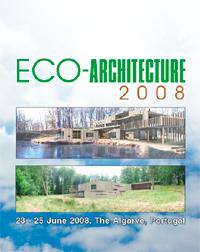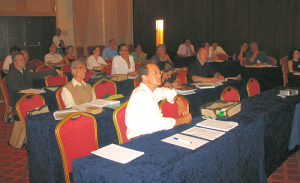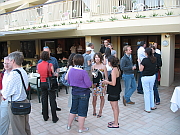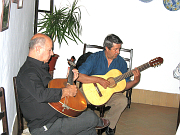Second International Conference on Harminisation Between Architecture and Nature
![]() 23 - 25 June 2008
23 - 25 June 2008
Algarve, Portugal
Overview
 The 2nd International Conference on Harmonisation between Architecture and Nature (Eco-Architecture) took place recently in the Algarve, Portugal, organised by the Wessex Institute of Technology of the UK. The Conference follows the very successful meeting held at the New Forest Campus of the Wessex Institute in the UK.
The 2nd International Conference on Harmonisation between Architecture and Nature (Eco-Architecture) took place recently in the Algarve, Portugal, organised by the Wessex Institute of Technology of the UK. The Conference follows the very successful meeting held at the New Forest Campus of the Wessex Institute in the UK. Eco-Architecture provides design in harmony with nature, including its immediate environments. Decisions are taken on ecological grounds covering location, siting and orientation, as well as the well-informed choice of materials.
Eco-Architecture makes every effort to minimise the use of energy at each stage of the building’s life cycle, including that embodied in the extraction and transportation of materials, their fabrication, their assembly into the building and ultimately the ease and value of their recycling when the building’s life is over. The design ought also to take into account the use of energy in building maintenance and changes in its use, not to mention its lighting, heating and cooling, particularly when the energy concerned involves the emission of greenhouse gases.
The development of eco-architecture is driven by the depletion of natural resources, especially fossil fuels and the need to preserve the balance of nature. The extensive use of steel and glass and the built-in problems of discomfort from solar over-heating and winter heat loss, has led to the widespread use of mechanical systems, which by careful design, could have been avoided in almost any climate.
 The Meeting was opened by Prof Carlos A. Brebbia, Director of Wessex Institute of Technology, who welcomed the delegates and explained that his Co-Chairman, Professor Geoffrey Broadbent, could not attend the Conference for medical reasons. He was very sorry to miss the Conference but was not permitted to travel in his present condition.
The Meeting was opened by Prof Carlos A. Brebbia, Director of Wessex Institute of Technology, who welcomed the delegates and explained that his Co-Chairman, Professor Geoffrey Broadbent, could not attend the Conference for medical reasons. He was very sorry to miss the Conference but was not permitted to travel in his present condition. Carlos then explained some of the work carried out by WIT. The emphasis of the Institute’s activities is on transdisciplinary cooperation, bringing together many different partners across the spectrum of academia, research institutes and industries. WIT collaborates with many institutions around the world and has formal links with nearly 50 establishments.
Recently, Carlos said, many of the research activities of WIT have concentrated on the solution of ecological and environmental problems, contributing in most cases with the unique expertise of WIT in the field of modelling. The Institute is renowned throughout the world as the developer of the new numerical technique called boundary elements, and which is simpler to use than traditional domain techniques (such as finite differences, finite elements and others). It also carries out pioneering research in the field of damage mechanics, particularly crack propagation and corrosion protection systems.
Finally, Carlos referred to the publishing activities of WIT, which comprises the eLibrary where all conference papers are archived as well as other specialised books. The publishing arm of WIT, called WIT Press, is always interested in receiving proposals for new books, especially those in the field of Architecture and Cultural Heritage.
Conference Sessions
 The conference papers were organised in a series of sessions as follows:
The conference papers were organised in a series of sessions as follows: - Design with nature
- Design by passive systems
- Rehabilitation and adaptive re-use
- Ecological and cultural sensitivity
- Case studies
- Resource conservation and building technologies
- Shape and Form in Engineering and Nature
- Nature and Architectural Design
Invited Lectures
There were a number of invited lectures as follows:- “The dislocation of composition: architecture and eco-sustainability”, by A Sichenze, University of Basilicata, Italy
- “Learning from vernacular architecture: sustainability and cultural conformity”, by BA Kazimee, Washington State University, USA
- “Generation post-fossil” by M Despang, University of Nebraska at Lincoln, USA
- “The 2007 Solar D House” by M Garrison, The University of Texas at Austin, USA
- “Fail safe design with crack stoppers and warnets” by C Wissner, Institute for Material Research II, Karlsruhe, Germany
- “Hands-on learning: the ecoMOD project”, by JD Quale, University of Virginia, USA
Social Activities
The Conference offered numerous occasions for the delegates to meet and discuss their work. They had lunch together each day and a special BBQ reception was arranged at the end of the first day. This helped to create a friendly atmosphere.The Conference banquet took place in a typical Portuguese restaurant located in an old Algarve village. The dinner consisted of typical Portuguese dishes and excellent wines. During the banquet, the delegates were entertained by a Fado Group with excellent performers. The whole occasion was very friendly and helped to strengthen links among the delegates.


The success of the meeting led to its being reconvened – date and location to be announced in due course.
Publication of Papers
The proceedings of Eco-Architecture II: Harmonisation between Architecture and Nature, 368pp (ISBN: 1-84564-119-1) are available in hard back from WIT Press priced at £121/US$242/€181.50. Orders can be placed by telephone: +44 (0) 238 029 3223, fax: +44 (0) 238 029 2853, e-mail:
Papers from the conference will also be hosted online at the WIT eLibrary as volume 113 of WIT Transactions on Ecology and Environment (ISSN: 1743-3541). For more details visit the WIT eLibrary at: library.witpress.com.


 Wessex Institute
Wessex Institute